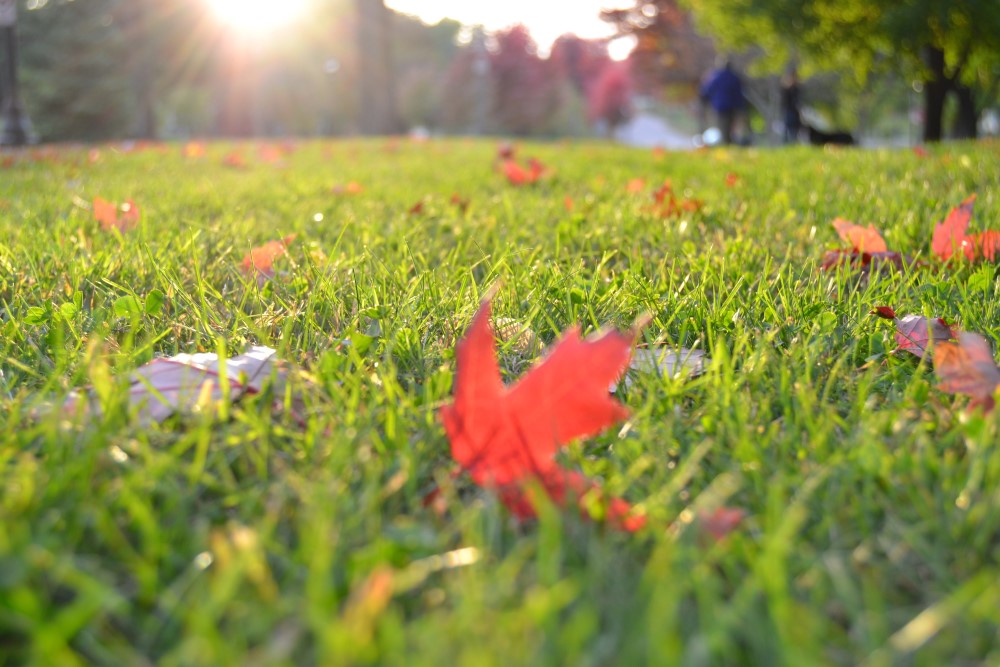
Credits to Jennifer Victor-Larsen
Maintaining a beautiful and healthy lawn requires more than just regular mowing, watering, and fertilization. There are several lesser-known tricks and techniques that homeowners can use to promote healthy growth, prevent damage, and achieve a lush and vibrant lawn. In this article, we’ll discuss some of the lesser-known tricks to take care of a lawn.
- Test Your Soil
Testing your soil is an essential first step in understanding your lawn’s needs and developing a proper care plan. Soil testing can help you determine the pH level, nutrient levels, and other characteristics of your soil, which can influence the health and appearance of your lawn. You can purchase a soil testing kit or hire a professional to perform the test for you. - Use Natural Lawn Fertilizers
Using natural fertilizers, such as compost or organic fertilizers, can promote healthy growth and reduce the risk of chemical runoff or environmental damage. Natural fertilizers also help improve soil health by promoting the growth of beneficial microorganisms and improving soil structure. - Practice Deep Watering
Deep watering is essential for promoting healthy root growth and preventing damage from drought. Instead of frequent shallow watering, which can encourage shallow root growth and increase the risk of disease, water your lawn deeply and infrequently, allowing the water to penetrate the soil to a depth of 6-8 inches. - Aerate Your Lawn
Aeration can help reduce soil compaction, improve drainage, and promote healthy root growth. You can use a specialized machine, called an aerator, or a simple garden fork to aerate your lawn. - Mulch Grass Clippings
Mulching grass clippings can help improve soil health and reduce the need for fertilization. When you mow your lawn, leave the grass clippings on the lawn instead of bagging them. The grass clippings will decompose, releasing nutrients back into the soil and promoting healthy growth. - Use Beneficial Insects
Beneficial insects, such as ladybugs, lacewings, and praying mantis, can help control pests in your lawn without the use of harmful chemicals. Beneficial insects feed on pests, such as aphids and caterpillars, and can help reduce the risk of pest damage and infestations. - Plant Native Plants
Planting native plants, such as wildflowers or grasses, can help promote a healthy and diverse ecosystem in your lawn. Native plants are adapted to the local climate and soil conditions, and can help improve soil health, reduce water usage, and support local wildlife. - Practice Companion Planting
Companion planting is the practice of planting different plants together to promote healthy growth and reduce the risk of pests and diseases. For example, planting marigolds near your vegetable garden can help repel pests, while planting clover in your lawn can help fix nitrogen in the soil and reduce the need for fertilization. - Use Natural Pest Control Methods
Using natural pest control methods, such as essential oils or soap solutions, can help control pests without the use of harmful chemicals. Natural pest control methods are safer for the environment and can help maintain a healthy and balanced ecosystem in your lawn. - Consider Drought-Tolerant Grasses
In areas with limited water resources, such as Woodstock, GA, consider planting drought-tolerant grasses, such as Bermuda grass or Zoysia grass. Drought-tolerant grasses are adapted to dry conditions and require less water, fertilizer, and maintenance than traditional grasses. - Use Corn Gluten Meal as a Weed Preventer
Corn gluten meal is a natural byproduct of corn processing that can be used as a weed preventer. When applied to your lawn, corn gluten meal releases an organic compound that inhibits the germination of weed seeds. Corn gluten meal is safe for use around children and pets, and can help reduce the need for harmful chemical weed control methods. - Use Epsom Salt as a Fertilizer
Epsom salt, or magnesium sulfate, can be used as a natural fertilizer to promote healthy growth and color in your lawn. Epsom salt contains magnesium and sulfur, two essential nutrients for plant growth. When applied to your lawn, Epsom salt can help improve soil health, increase nutrient uptake, and reduce the risk of stress and damage. - Use Molasses as a Soil Amendment
Molasses is a natural byproduct of sugar production that can be used as a soil amendment to promote healthy growth and reduce the risk of disease. Molasses contains sugars and other organic compounds that can help feed beneficial microorganisms in your soil, such as bacteria and fungi. When applied to your lawn, molasses can help improve soil structure, increase nutrient uptake, and reduce the risk of soil-borne diseases. - Use a Lawn Sweeper
Using a lawn sweeper, also known as a leaf sweeper, can help keep your lawn clean and free of debris. Lawn sweepers are designed to pick up grass clippings, leaves, and other debris from your lawn, reducing the risk of disease and damage. Lawn sweepers are easy to use and require minimal maintenance, making them a convenient tool for maintaining a healthy lawn. - Use Compost Tea as a Fertilizer
Compost tea is a natural fertilizer made from compost and water. When brewed properly, compost tea contains a high concentration of beneficial microorganisms, such as bacteria and fungi, that can help improve soil health and promote healthy growth. Compost tea can be applied to your lawn using a spray bottle or watering can, and can help reduce the need for chemical fertilizers and pesticides.
Maintaining a healthy and beautiful lawn requires more than just regular watering and mowing. By using these lesser-known tricks and techniques, you can promote healthy growth, reduce the risk of damage and disease, and achieve a lush and vibrant lawn. Whether you use natural fertilizers, practice deep watering, use beneficial insects, or consider drought-tolerant grasses, there are many ways to maintain a healthy and beautiful lawn without the use of harmful chemicals or costly treatments.
Comments